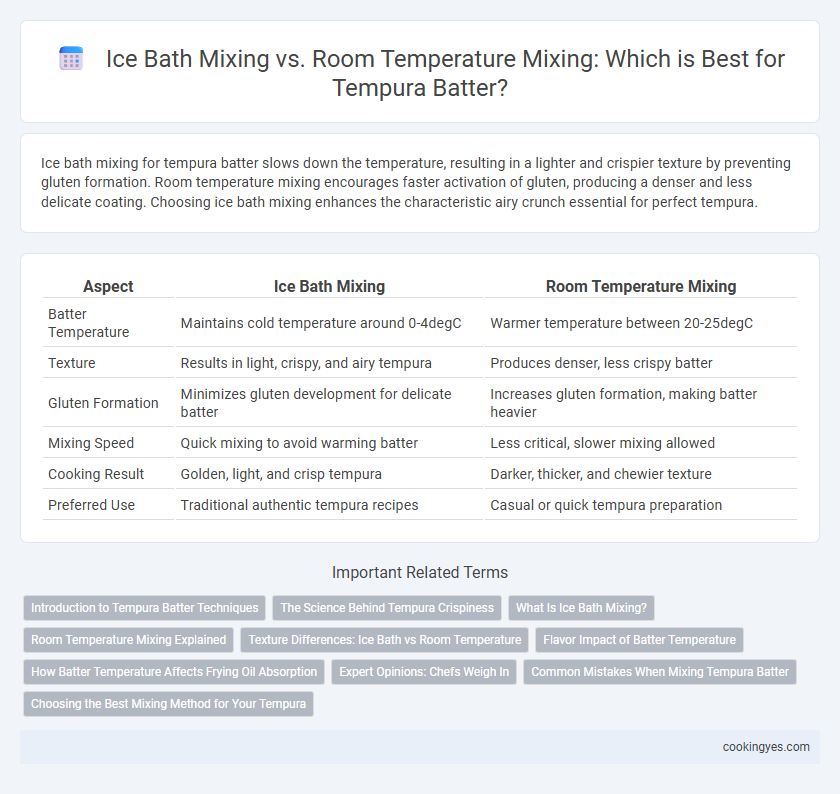Ice bath mixing for tempura batter slows down the temperature, resulting in a lighter and crispier texture by preventing gluten formation. Room temperature mixing encourages faster activation of gluten, producing a denser and less delicate coating. Choosing ice bath mixing enhances the characteristic airy crunch essential for perfect tempura.
Table of Comparison
| Aspect | Ice Bath Mixing | Room Temperature Mixing |
|---|---|---|
| Batter Temperature | Maintains cold temperature around 0-4degC | Warmer temperature between 20-25degC |
| Texture | Results in light, crispy, and airy tempura | Produces denser, less crispy batter |
| Gluten Formation | Minimizes gluten development for delicate batter | Increases gluten formation, making batter heavier |
| Mixing Speed | Quick mixing to avoid warming batter | Less critical, slower mixing allowed |
| Cooking Result | Golden, light, and crisp tempura | Darker, thicker, and chewier texture |
| Preferred Use | Traditional authentic tempura recipes | Casual or quick tempura preparation |
Introduction to Tempura Batter Techniques
Tempura batter requires precise temperature control to achieve its signature light and crispy texture, with ice bath mixing slowing gluten formation and preventing overactivation of starches. Mixing the batter in an ice bath keeps the temperature low, preserving carbonation and producing a delicate, lacy coating that enhances frying results. In contrast, room temperature mixing accelerates gluten development, leading to a denser, heavier crust less desirable in traditional tempura preparation.
The Science Behind Tempura Crispiness
Ice bath mixing of tempura batter slows gluten development and prevents premature oxidation of starches, resulting in a lighter, crispier coating. Cooler batter temperature reduces oil absorption during frying by creating a stronger protein network that seals moisture inside the shrimp or vegetable. Room temperature mixing accelerates gluten formation and increases oil uptake, producing a denser, less crunchy tempura texture.
What Is Ice Bath Mixing?
Ice bath mixing for tempura batter involves chilling the mixing bowl in a container of ice water to keep the batter cold during preparation. This technique slows gluten development, resulting in a lighter, crispier tempura coating. Maintaining a low temperature prevents the batter from becoming too thick and ensures a delicate, airy texture when fried.
Room Temperature Mixing Explained
Room temperature mixing for tempura batter promotes the optimal hydration of starch and proteins, resulting in a lighter, crispier texture when fried. Maintaining the batter at room temperature allows for better gluten development control, ensuring the coating remains delicate rather than heavy or chewy. Chefs often prefer this method to achieve consistent frying performance and a golden, airy finish.
Texture Differences: Ice Bath vs Room Temperature
Mixing tempura batter in an ice bath creates a lighter, crispier texture by slowing gluten formation and preserving carbonation, resulting in a delicate, airy coating. Room temperature mixing accelerates gluten development, producing a denser, heavier batter with less crispness and a chewier bite. The temperature of the mixing environment directly influences the oil absorption and frying performance, making ice bath mixing the preferred method for optimal tempura texture.
Flavor Impact of Batter Temperature
Tempura batter mixed in an ice bath maintains a cooler temperature that prevents excessive gluten development, resulting in a lighter and crispier texture with a more delicate flavor profile. In contrast, batter mixed at room temperature tends to activate gluten faster, producing a denser coating that can mask the subtle umami of fresh ingredients. Maintaining cold batter temperature is crucial for enhancing the traditional airy crispness and elevating the overall flavor experience of tempura.
How Batter Temperature Affects Frying Oil Absorption
Ice bath mixing for tempura batter significantly reduces oil absorption by maintaining a cold temperature that slows gluten development and prevents the batter from becoming dense. Room temperature mixing promotes quicker gluten formation, leading to a thicker batter that absorbs more frying oil and results in a greasier texture. Keeping tempura batter cold through ice bath mixing ensures a lighter, crispier coating with minimal oil retention during frying.
Expert Opinions: Chefs Weigh In
Expert chefs emphasize that ice bath mixing for tempura batter enhances its lightness and crispiness by preventing gluten formation and controlling batter temperature. Room temperature mixing often leads to thicker, heavier batter that absorbs more oil, resulting in less delicate fried tempura. Renowned culinary experts note that maintaining cold batter through ice bath mixing is crucial for achieving the signature airy texture and golden crunch in authentic tempura preparation.
Common Mistakes When Mixing Tempura Batter
Using ice-cold water when mixing tempura batter is crucial to achieve a light, crispy texture, as room temperature water can cause excessive gluten development, resulting in a dense, heavy coating. A common mistake is overmixing the batter, which activates gluten and compromises the desired crispiness. Experts recommend minimal stirring with chopsticks until just combined to maintain the batter's airy consistency.
Choosing the Best Mixing Method for Your Tempura
Mixing tempura batter in an ice bath helps maintain a cold temperature, resulting in a lighter, crispier texture compared to room temperature mixing. The cold batter prevents gluten formation, essential for achieving the signature delicate crunch. For the best tempura, choose ice bath mixing to ensure optimal lightness and crispiness in the final dish.
Ice Bath Mixing vs Room Temperature Mixing for Tempura Batter Infographic

 cookingyes.com
cookingyes.com